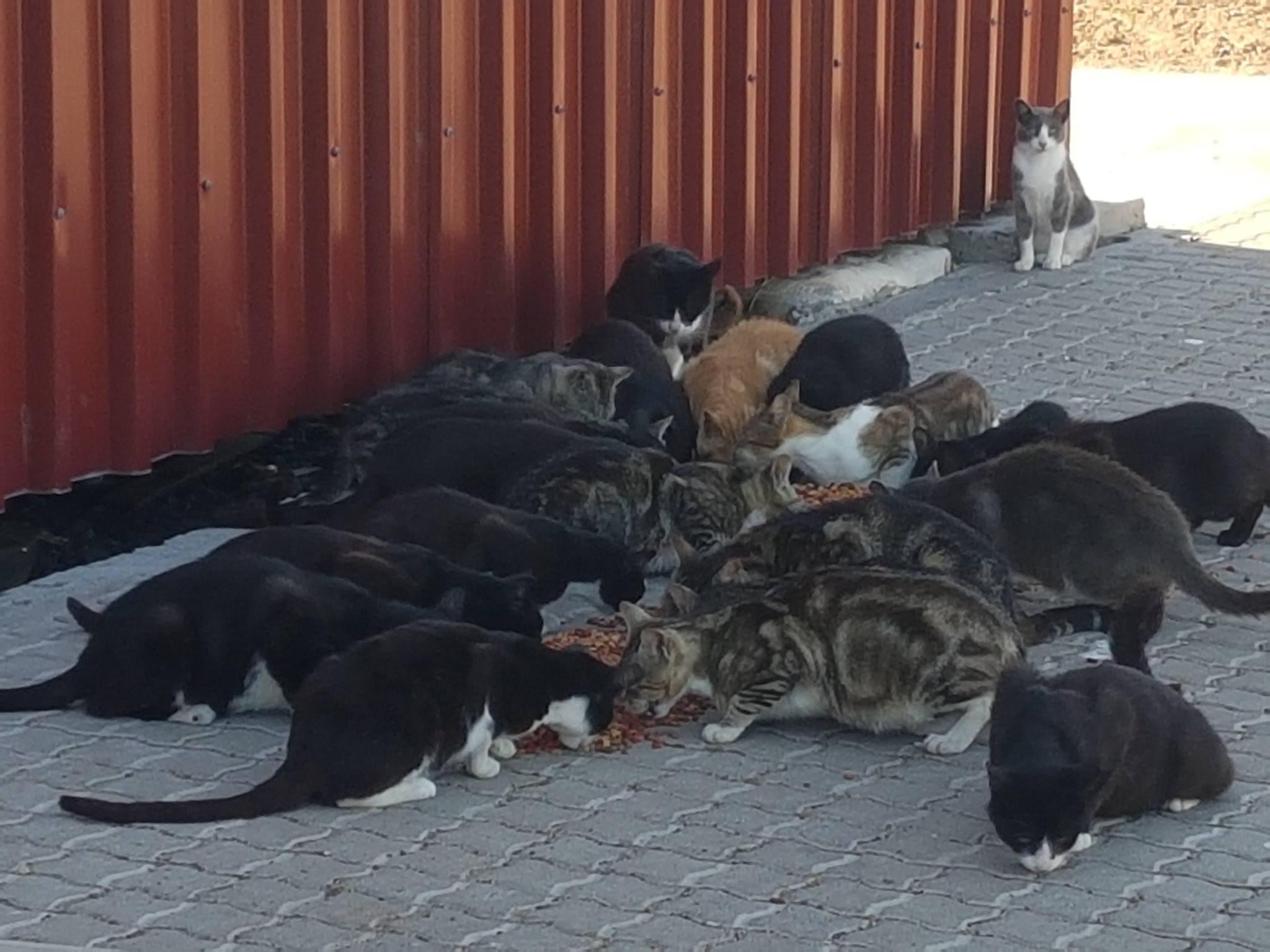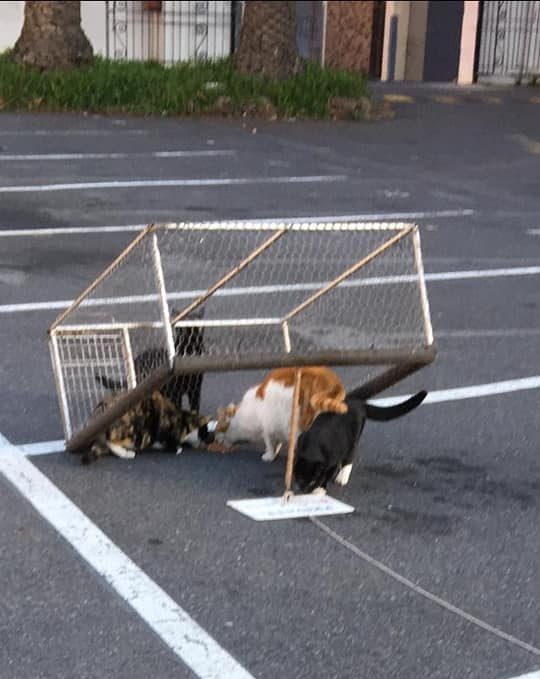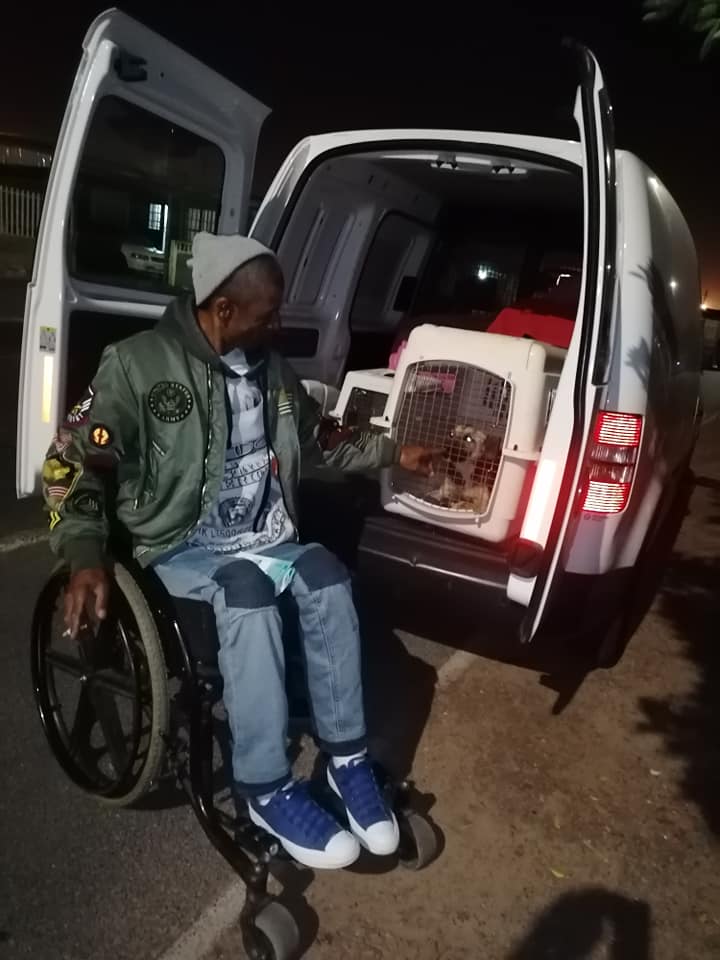Feral Cat Project Cape Town
Feral cats are no more “homeless” than squirrels, mongooses, or any other small mammals; their chosen area is their home. Here they learn to live, adapt and thrive — often with help from a human caretaker. It’s important to understand what feral cats are:
A true feral is one born of an abandoned or stray pet − an unsterilised cat that got ‘lost’ following their hormones. An unneutered male will roam for kilometres away to find a mate. Without early contact with humans they are not used to us and will avoid contact as much as possible. An unsterilised female can get pregnant from four months old. She can produce up to three litters a year. Hence female cats appear thin and staved. Without intervention, the cycle of breeding continues, resulting in exponential growth in the number of cats in a colony.
Some cats that end up in colonies are actually lost domestic cats. In some cases, people abandon their animals because they can no longer afford them, or they no longer want them. These domestic cats have to adapt to life the best they can and often become very wary of humans.
Placing feral cats into a rescue shelter is not the answer. Being ‘caged’ and confronted with humans with no escape is extremely scary for them. The mental trauma affects their health and longevity. Ferals in shelters end up being euthanised because they are not adoptable, despite them being healthy.
Feral cats are also known as community cats. The term ‘community’ has more positive connotations compared to ‘feral’. ‘Community’ indicates that the animal has a role to play in its environment, for example, keeping a rat population under control. With the help of feeders, community cats thrive.
So why a feeding program?
Like all animals, cats think with their stomachs. They are opportunistic and will eat food that is easiest to find. Community cats are often found near bins in residential areas, industrial areas, office complexes, and shopping centres. These are often areas that are quiet from around 7pm to 7am. During the quiet times, community cats are more relaxed so they wander about. We are increasingly seeing community cats in areas where people establish informal housing.
Think ‘like a cat’ − it makes sense to live where food is readily available.
Think ‘like a cat’ & it makes sense that they make their homes where food is readily available.
Feeding stations: Volunteers, or on site staff feed the cats, in an acceptable place. A regular schedule (either daily or 3 times a week) ensures that the cats have reliable source of food. Cats on a regular feeding schedule are less likely to wander elsewhere and possibly cause a nuisance.
Feeding times: Cats quickly learn when is feeding time. They recognise the sound of their feeder’s car, or the shaking of a food bag. Fresh water is always provided.
• Newcomers: The feeder gets to know the cats and can keep track of any newcomers to the colony. Any new cat is advertised on social media networks in case it is someone’s missing cat. Otherwise a TNR is planned to ensure the cat is sterilised.
Rodent control: Although cats can assist with rodent control, hunting requires energy. A starving cat’s body will shut down and ultimately result in a slow, painful death.
If sterilised cats can meet all their needs in one place food, water, and shelter – they won’t feel a strong urge to wander.


What is TNR & is trapping humane?
Trap−Neuter−Return (TNR) describes the practice of trapping, sterilising, and returning community cats.
Trap: Once a feeding schedule is established, a cat can be trapped at a time and place when and where food is provided. The trap is set close to the feeding station. The cats are lured into a trap by smelly food, like sardines. A trap is a cage that automatically closes when the cat goes in. There are two main types of automatic traps: one that closes when a cat bites hanging food, and one that closes when the cat stands on a plate to get to food at the back of the trap. Some traps are closed manually by pulling a long string. To help the cat feel ‘safe’ once inside the trap, a blanket is immediately put over the trap. Traps are never left unattended as not being covered could cause a cat to panic and thereby injure itself. Our volunteers give up many hours to trap cats, as not all cats take the bait quickly.
Neuter: The cats are taken to the vet for sterilisation. This is the only way to stabilise feral cat populations. They also get their ear ‘tipped’. The tip of one ear is snipped off while the cat is under anaesthesia. Ear tips are a universal sign indicating that a cat has been sterilised and will not require trapping again.
Return: The cat is then returned to the place where it was trapped. Kittens, if caught young enough to be tamed, are fostered, and then put up for adoption. Taming feral kittens is not always practical as it is highly time consuming. Many kittens are returned to their colonies.
TNR keeps the number of cats in a colony under control. Sterilised cats have a better life with access to shelter and food. Sterilised female cats don’t go into heat, so they attract fewer unsterilised male cats to the area. This reduces the spread of diseases. An unneutered male can smell a female in heat from a few kilometres away – this is why so many unsterilised young males go missing from homes every year.
Sterilising a cat means they also spray less, fight less, and make less noise. Because sterilised cats roam less, the risk of injury, cancer, or being hit by a car is also reduced.
Removing all the cats from an area is never the answer – they came there in the first place as opportunistic feeders – so over time new ones will arrive to fill the void. This has been proven many times globally. Cats know that their food supply and other recourses are finite. Maintaining a healthy colony means the cats will protect, and if necessary, defend their position against too many newcomers.
TNR is therefore the humane thing to do.


Our weekly clinic on Thursdays
The Feral Cat Project runs a sterilisation clinic every Thursday. Our amazing team consists of Dr Tracy Dicks, two nurses, and two assistants. The clinic in based in Sunnydale, Cape Town. The clinic is funded by donations from the public. Rabbits are also sterilised due to a overwhelming need.
We sterilise up to 85 cats and kittens each week in peak breeding season.
Kittens are successfully sterilised from 8 weeks old.
Where necessary, we administer vaccinations, test for feline AIDS and leukaemia, and microchip adoptable kittens/cats.
Community cats are all ear tipped.
All cats are collected/ trapped by volunteers and brought to an arranged location. From there the cats are transported to the surgery in Sunningdale. After surgery all cats are returned to their homes.

Community cat support
In line with our desire to control feral and lost cat populations, we assist people who can’t afford to sterilise their cats.
Many cats are loved and cared for by people who can’t afford the cost of sterilisation. They often also lack transport and cat carriers. Volunteers drop off carriers a day or so in advance. Volunteers collect and return the cats.
Strays often appear in people’s gardens. They feed the cat, and try to find the owner, to no avail. Not before long, the female is impregnated, or the male is spraying everywhere and fighting with every cat in the street! It was not something they had thought of but the cat needs to be sterilised. If the cat is friendly, they may be able to place the cat in a carrier. If the cat isn’t friendly, they need help to trap the cat.
People at factories, industrial areas, office complexes, or residential areas suddenly notice cat/s. People are willing to feed them but are unable to afford the cost of feeding kittens too. A TNR volunteer will help catch the cats for sterilisation. We ask for a donation to help cover the sterilisation costs. A minimal cost ensures that we can assist more cats.
Our aim is to keep the cat population in the Cape Town area from rising uncontrollably. In 2020, we sterilised 3148 cats. Over the last 5 years, we have sterilised 12 768 cats. Controlling the cat population helps to prevent the spread of disease, injury, and nuisance situations.


Why foster?
Fostering saves lives. Kittens born outside have a very low survival rate. They are often eaten by other animals, hit by cars, or killed by humans who see kittens as a nuisance. Kittens brought in or trapped that are young enough to be socialised can enjoy a home life where they will be pampered and loved. A home environment is much safer than going back with their mother who belongs in the community and is happy there.
Kittens remain in a foster home until they are adopted. They are not put into a shelter’s cattery.
Click here to see Fabulous feline adoptions Facebook page for kittens currently ready for adoption.
Benefits of fostering:
Kittens grow up in a safe and healthy environment.
They receive the much needed one-on-one human contact. Socialisation ensures that the kittens are adoptable. In foster care, kittens enjoy a lot of playtime, which stimulates their mental and physical health.
Kittens is foster care get used to people, children, maybe a dog or other cats. They become accustomed to domestic dynamics (such as screaming children and barking dogs). They settle better in their forever homes than if they were raised in a shelter.
Kittens in foster care are given the opportunity to let their personality develop and shine. Every caregiver enthusiastically gives real and trusted assessments of the kitten’s personality and needs. Plus a million photos.
Foster caregivers are the kitten’s temporary parents and their biggest publicist, resulting in successful adoptions.
With every adoption a little bit of a foster parent’s heart goes with, but they know they gave these babies the very best start in life. There are always more kittens in need.


How can you help?
As we grow and expand help is always needed.
Donate
Funds: donations enable us to continue the work we do. Our main focus is sterilising cats. We also require funds to feed the colonies, foster kittens, and to buy or maintain existing equipment (including traps and medical apparatus)
Funds: donations enable us to continue the work we do. Our main focus is sterilising cats. We also require funds to feed the colonies, foster kittens, and to buy or maintain existing equipment (including traps and medical apparatus)
– R350 covers the cost of sterilising one cat
– R100 covers the cost of feeding one feral cat for a month
– R800: new trap
– Surgery kits, drapes, servicing the machinery & sharping bladesEquipment. Traps are bought which is very necessary in this field of work. Medical equipment purchased for the surgery which enables the Dr & team to do their job.
Get invovled
Trapping, feeding, and fostering kittens is a passion that requires commitment. Training is given to new volunteers by an experienced mentor. We provide support throughout the process. The project is run by a skilled group of women who support each other.
Future goals
Sterilise as many cats and rabbits as possible. Our goal for 2021 is to sterilise 3500 cats.
Extend feeding program
Buy a property to create a centre for sick and abused animals to recover in a calm environment. The centre will include a theatre for sterilisations and medical emergencies.
